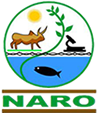Fish species occurrence and composition in the upper Victoria Nile (UVN), a stretch connecting Lakes Victoria and Kyoga DataSet Details
Description:
This dataset contains occurence records and associated abundance data (number and weight), where available, and sample length collected from selected sites along the upper Victoria Nile (UVN) between 2007 and 2016, i.e., before, during, and after the construction of dams.
Purpose:
The data were collected as part of the long-term monitoring effort to assess the ecological impact of hydro-power dams on fish species diversity, with special emphasis on haplochromines. This dataset can reveal the potential ecological impact of dams on fish diversity, especially the endemic haplochromines that are adapted to living in rocky habitats of fast flowing rivers.
Temporal scope:
2007-2016
Taxonomic scope:
5 orders;
7 families;
23 genera;
52 species.
Methodology:
Sampling stations were based on the operational area of impact of the dams, and they included upstream, reservoir, and downstream stations for each dam. In these stations, sampling gear were deployed at points selected based on uniqueness in relation to the known habitat preferences for the fishes such as rocky, sandy, muddy, vegetated areas, and water current. These specific habitats chosen for sampling also guided the choice of the fishing method employed. Stations with rocky habitats were sampled using hooks, while those with vegetated shores were sampled using gillnets. In some instances, a combination of hooks and gillnets were used. Fish sampling was carried out using a combination of monofilament and multifilament gillnets of stretched mesh sizes 1 to 6 inches in increments of 0.5 inches. Monofilament gillnets were normally set during day time (for about 1 hour), and setting was repeated at stations where the catch was not representative of local diversity. Multifilament gillnets were set for the whole night (deployed in the evening and retrieved at dawn). In habitats where gillnets could not be used, especially rocky areas, hooks of sizes number 18 and 20 were used. In a few cases, a beach seine was used. After hauling, individual fish specimens were photographed alive in a cuvette, using a digital camera and identified to the lowest possible taxon (Seehausen, 2016). Because the majority of the species endemic to the Nile River are un-described, those fishes that could not be identified to species level were given cheironyms (see Seehausen and Wandera, 2016). In some cases, photographs of the fish were sent to experts, especially Ole Seehausen, for final identification.
Bibliography:
Seehausen, O. (2016). Victoria Nile Haplochromine survey 2016 First compilation of species. A pictorial guide.
Seehausen, O., Wandera, S. (2016). Quick guide to Ugandan rocky shore cichlids arranged by genus. A pictorial guide.
Citation:
Laban M, Vianny N, (2020). Fish species occurrence and composition in the upper Victoria Nile (UVN), a stretch connecting Lakes Victoria and Kyoga. Version 1.4. National Fisheries Resources Research Institute. Occurrence dataset http://freshwaterbiodiversity.go.ug/dataset/?code=bXRV6mqMbWk1bcQGsYWCVC0a34WChZkN&version=2. accessed via freshwaterbiodiversity.go.ug on 23 Oct 2024.
Number of Occurrencies:
0 Records
Authors:
Laban Musinguzi
Vianny Natugonza

" thank you for providing this useful data "
Oct. 20, 2021, 4 p.m.